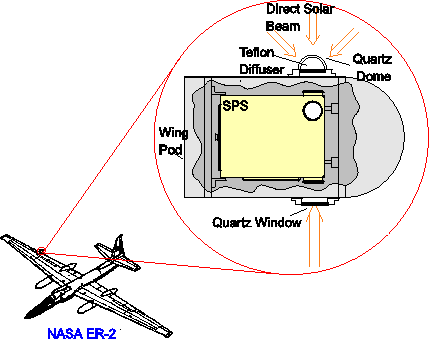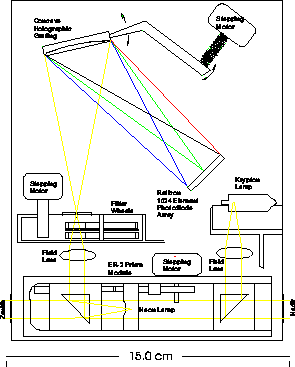 |
Principle Investigator: C.T. McElroy, Environment Canada
Co-investigators: C. Midwinter, Environment Canada; J.C. McConnell, York University
CPFM articles: Profiles and York University Gazette
| Instrument Type | UV-visible spectroradiometer |
| Dimensions | 10 cm x 15 cm x 25 cm |
| Weight | xx |
| Material | xx |
| Dispersive Element | Concave holographic grating |
| Detector | Reticon EG&G 1024-element photodiode array |
| Fields Measured | Downwelling Irradiance Limb Radiance (Horizontal Component) Limb Radiance (Vertical Component) Nadir Radiance (Along-track Component) Nadir Radiance (Cross-track Component) |
| Field of View (nadir and limb) |
0.1o x 10o (nadir footprint is 0.035 km x 3.5 km for ER-2 at 20 km) |
| Spectral Windows | 375-775 nm - First Order
188-388 nm - Second Order |
| Effective Spectral Range | 300-770 nm |
| Spectral Resolution | about 1 nm |
| Wavelength Assignments | accurate to 0.05 nm |
| Uncertainities | Absolute - about 10% Relative - about 3% |
Historical Perspective
The CPFM was included as part of the large instrumentation suite
on the ER-2 in 1992 for the Stratospheric Photochemistry, Aerosols
and Dynamics Expedition (SPADE). Its original purpose was
to make measurments of the radiation field so that photolysis rates
could be calculated directly, as opposed to replying upon numerical
radiative transfer models. Other useful early applications of CPFM
measurements were measuring the column ozone above the ER-2 and the
wavelength-dependent apparent surface reflectivity (albedo).
Each of these are relatively straightforward applications of the
CPFM data.
The spectral resolution of the CPFM was high enough that the
absorption features of ozone, NO2, and BrO could be
clearly identified.
Since its inclusion in the SPADE campaign (1992-1993), the CPFM has
flown on the ER-2 for ASHOE/MAESA (Antarctic Southern Hemisphere
Ozone Experiment/Measurements for Assessing the Effects of
Stratospheric Aircraft) in 1994, STRAT (Stratospheric Tracers of Atmospheric
Transport) in 1995-96, and POLARIS (Photochemistry of Ozone Loss in the
Arctic Region In Summer) in 1997. Furure campaings in which the CPFM will
participate include SOLVE (SAGE III Ozone Loss and Validation Experiment) in
1999-2000.
 |
 |
| Mean Radiance (a.k.a. Actinic Flux) |
| Limb and Nadir Linear Polarization |
| Apparent Surface Reflectivity |
References:
1. McElroy, C.T., C. Midwinter, D.V. Barton, and R.B. Hall, A
comparison of J-values estimated by the Composition and Photodissociative
Flux Measurement with model calculations, Geophys. Res. Lett.,
22 , 1361-1364, 1995.
2. McElroy, C.T., A spectroradiometer for the measurement of direct
and scattered solar irradiance on-board the NASA ER-2 high altitude research
aircraft, Geophys. Res. Lett., 22 , 1365-1368, 1995.
3. McElroy, C.T., C. Midwinter, D.V. Barton, and R. Hall,
Measurement of the column ozone above the NASA ER-2 stratospheric
research aircraft, in Atmospheric Ozone , edited by R.D. Bojkov
and G. Visconti, Proceedings of the Quadrennial Ozone Symposium, L'Aquila,
Italy, September 1996, 943-946, 1998.
4. McLinden, C.A., J.C. McConnell, C.T. McElroy and E. Griffioen,
Sensitivity of polarized limb radiances to stratospheric
aerosols with application to NASA ER-2 spectroradiometer measurements,
in Atmospheric Ozone , edited by R.D. Bojkov and G. Visconti,
Proceedings of the Quadrennial Ozone Symposium, L'Aquila, Italy,
September 1996, 947-950, 1998.
5. McElroy, C.T., C.A. McLinden, and J.C. McConnell, Evidence of bromine
monoxide in the free troposphere during the Arctic polar sunrise,
Nature , 397 , 338-341, 1999.
6. McLinden, C.A., J.C. McConnell, C.T. McElroy, and E. Griffioen,
Observations of stratospheric aerosol using CPFM polarized limb
radiances, J. Atmos. Sci., 56 , 233-240, 1999.
7. McLinden, C.A., J.C. McConnell, E. Griffioen, C.T. McElroy, and
L. Pfister, Estimating the wavelength-dependent ocean albedo under clear
sky conditions using NASA ER-2 spectroradiometer measurements,
J. Geophys. Res., 102, 18801-18811, 1997.
8. McLinden, C.A., Observations of Atmospheric Composition
From NASA ER-2 Spectroradiometer Measurements ,
Ph.D. thesis, York University, Toronto, pp. 298, 1998.